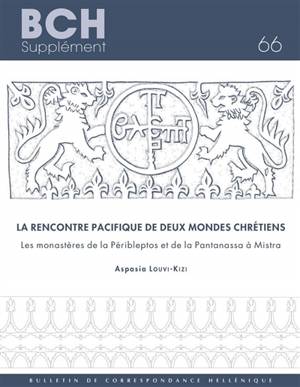
- Afhalen na 1 uur in een winkel met voorraad
- Gratis thuislevering in België vanaf € 30
- Ruim aanbod met 7 miljoen producten
- Afhalen na 1 uur in een winkel met voorraad
- Gratis thuislevering in België vanaf € 30
- Ruim aanbod met 7 miljoen producten
La rencontre pacifique de deux mondes chrétiens
les monastères de la Péribleptos et de la Pantanassa à Mistra
Aspasia Louvi-KiziOmschrijving
En publiant en français cet ouvrage, dont une première version a d'abord paru en grec sous les auspices de l'Académie d'Athènes, l'École française d'Athènes fait connaître les recherches d'une grande spécialiste du Péloponnèse franc et byzantin, Aspasia Louvi-Kizi, dont le travail révèle toute la complexité des formes architecturales, des emprunts et des modèles repérables dans les monuments de la ville byzantine et médiévale de Mistra.
Parmi les créations architecturales du couple de despotes, Manuel Cantacuzène (1349-1380) et son épouse Isabelle de Lusignan, qui a façonné Mistra en un centre de pouvoir, Aspasia Louvi-Kizi analyse deux de ses monuments emblématiques, les monastères de la Péribleptos et de la Pantanassa, proposant une nouvelle histoire de leur construction.
Des éléments de l'art franc, c'est-à-dire occidental ou gothique, étrangers à la tradition byzantine locale, ont été incorporés dans leur architecture. Distincts de la production franco-byzantine de la principauté voisine d'Achaïe, ces éléments gothiques de Mistra ont plutôt à voir avec Part occidental de Chypre ; la contribution d'Isabelle à leur introduction dans le Péloponnèse est alors déterminante. Ces éléments occidentaux, qui ornent les clochers et les tours sur les façades, sont combinés avec les éléments byzantins et constituent une véritable expression de la politique pro-occidentale du couple de despotes, en symbiose avec la politique impériale de Constantinople à l'époque.
Dans le monde fragmenté et multipolaire de la Méditerranée orientale à la veille de la conquête ottomane, ce livre met ainsi en lumière le rôle de Mistra en tant que centre régional de pouvoir et contribue à sa réinterprétation.
En poursuivant ce dialogue international sur un site de renom, l'École française d'Athènes dit aussi son attachement aux regards croisés qui foht émerger la complexité des échanges à l'oeuvre dans cette histoire d'un monde grec en transition.
In publishing this book, an early version of which was first published under the auspices of the Academy of Athens, the French School at Athens highlights the research work of Aspasia Louvi-Kizi, an eminent specialist in the Frank and Byzantine Peloponnese, whose work reveals all of the complexity of the architectural forms, influences and models at work in the monuments of the medieval Byzantine city of Mystras.
Out of all of the architecture created by the despotic couple formed by Manuel Cantacuzène (1349-1380) and his wife Isabelle de Lusignan, who were instrumental in turning Mystras into a centre of power, Aspasia Louvi-Kizi focuses on two of the city's most iconic monuments, the monasteries of Peribleptos and Pantanassa, proposing a new history of their construction.
Their architecture incorporates elements of Frank art, meaning western or gothic art, which were foreign to the local Byzantine tradition. The gothic aspect of Mystras' architecture, as distinct from the Franco-Byzantine influences in the neighbouring crusader principality of Achaea, has more to do with Western art in Cyprus, and its introduction by Isabelle to the Peloponnese was to prove decisive. The Western elements that decorate the facades of clocks and towers, combined with the Byzantine features to constitute a concrete expression of the despotic couple's pro-Western politics, in line with the imperial politics of Constantinople at the time.
In the fragmented and multipolar world of the Eastern Mediterranean on the eve of the Ottoman conquest, this book highlights the role Mystras played as a centre of power in the region and, in doing so, contributes to a fresh take on the city as a whole.
By continuing the international conversation about a renowned site, the French School at Athens shows its commitment to a multilayered approach that reveals the complexity of the interactions at work in the history of the Greek world in transition.
Aspasia Louvi-Kizi, archéologue byzantiniste, docteur en histoire et civilisation du monde byzantin et post-byzantin (université Paris 1), a travaillé en France à l'Unesco et en Grèce dans la gestion culturelle et dans l'enseignement. Elle est aujourd'hui conseillère culturelle auprès de la Banque nationale de Grèce.
Specificaties
Betrokkenen
- Auteur(s):
- Vertaler(s):
- Uitgeverij:
Inhoud
- Aantal bladzijden:
- 416
- Taal:
- Frans
- Reeks:
- Reeksnummer:
- nr. 66
Eigenschappen
- Productcode (EAN):
- 9782869585744
- Verschijningsdatum:
- 23/08/2022
- Uitvoering:
- Paperback
- Formaat:
- Trade paperback (VS)
- Afmetingen:
- 190 mm x 240 mm
- Gewicht:
- 1000 g

Alleen bij Standaard Boekhandel
Beoordelingen
We publiceren alleen reviews die voldoen aan de voorwaarden voor reviews. Bekijk onze voorwaarden voor reviews.











